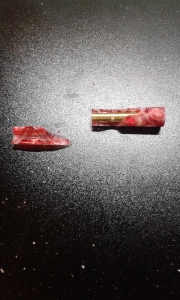Won't leave the best surface behind, as you move the chisel, but if you present a carbide bit at a 30 - 45 degree angle with the bevel horizontal (chisel flat on the toolrest), you'll be cutting with just the corner of the bit. With such little contact area, there is lower friction. Add this to a high speed turning rate, and there is less chance of a blowout and the chisel will cut easier.
By lifting the TRAILING EDGE of the chisel up off the tool rest and drawing the chisel towards yourself, you can achieve a type of shear cut that can give a better finished appearance as you work, but it will still not give a decently flat surface behind it unless you move your chisel VERY SLOWLY and evenly. Depend on sanding to achieve a nice appearance and flat surface.
Keep in mind that if your chisel is not flat against the toolrest, you have much less control over it. The chisel will cut better, but as is the case with most lathe tools ... they cut their best right before you lose control!
The usual use for a carbide chisel is to act as a scraper, rather than a gouge or a skew. Keep the tip of the carbide BELOW the center of your lathe spindle, and the handle of the chisel level or ABOVE the carbide bit. Keep the chisel flat against the tool rest, but you can TURN the handle to present just the corner of the bit, using the tool rest as your pivot point. This is the safest way to use carbides, and is generally the method taught to beginners using any type of scraper on the lathe.
There is no bevel to ride, just present the working tip properly while keeping the tool under full control and you're good to go!

Skews are a totally different animal. They can be used as scrapers, parting tools, bead and cove turning tools, tenon cutting tools, roughing using a peel cut, ect ... extremely versatile and extremely dangerous till you get the hang of it.
Bowl gouges are fairly versatile and generally very easy to learn to use. They are round on the bottom, so that you can present the tip or edges of the cutting surface to the work at an infinite variety of angles. They also have a bevel under the cutting edge that you can use to help guide your chisel, but there are methods of using gouges that do NOT use the bevel. Remember what I said about a tool cutting best right before you lose control of it? No bevel contact = extremely little control. But the shear cutting method utilizes this for one of the best cut surface appearance you'll likely ever see.
To achieve this (typically done on endgrain for fine box work), you tip the chisel up on it's SIDE, with the toolrest at an angle that allows you to present the flute itself right at your work ... you'll be cutting with the very side of the cutting edge on the lower flute, and you'll be turning at fairly high speed. This is an extremely fine cut, with almost NO PRESSURE AT ALL, barely tickling the surface as you slowly and carefully draw the chisel back towards you. If you get a catch while in this position, you could very well lose hold of the chisel itself and have it fly off, or other catastrophic things could happen ... this is a technique best practiced carefully with full safety equipment. It also works best with a bowl gouge that has been properly ground to best take advantage of this effect ... an Ellsworth grind or fingernail grind may work best.
The reason it works like that is that there is usually an extremely fine burr on the inner edges of the flute that doesn't get knocked off with typical use of the gouge ... only the tip gets the grunt work, so the side edges remain pristine much longer.
Use caution as you build your skills, so that you can enjoy using them without injuries in the way once you've mastered them!



